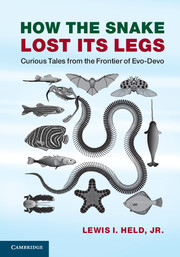Crossref Citations
This Book has been
cited by the following publications. This list is generated based on data provided by Crossref.
Martin, Arnaud
2015.
When evo–devo transcends the etiological myth.
Evolution & Development,
Vol. 17,
Issue. 2,
p.
170.
Sánchez-Villagra, Marcelo R.
and
Werneburg, Ingmar
2016.
Mammalian organogenesis in deep time: tools for teaching and outreach.
Evolution: Education and Outreach,
Vol. 9,
Issue. 1,
Yin, Wei
Wang, Zong-ji
Li, Qi-ye
Lian, Jin-ming
Zhou, Yang
Lu, Bing-zheng
Jin, Li-jun
Qiu, Peng-xin
Zhang, Pei
Zhu, Wen-bo
Wen, Bo
Huang, Yi-jun
Lin, Zhi-long
Qiu, Bi-tao
Su, Xing-wen
Yang, Huan-ming
Zhang, Guo-jie
Yan, Guang-mei
and
Zhou, Qi
2016.
Evolutionary trajectories of snake genes and genomes revealed by comparative analyses of five-pacer viper.
Nature Communications,
Vol. 7,
Issue. 1,
Tarasov, Sergei
and
Goldberg, Emma
2019.
Integration of Anatomy Ontologies and Evo-Devo Using Structured Markov Models Suggests a New Framework for Modeling Discrete Phenotypic Traits.
Systematic Biology,
Vol. 68,
Issue. 5,
p.
698.
Tarasov, Sergei
and
Buckley, Thomas
2019.
The Invariant Nature of a Morphological Character and Character State: Insights from Gene Regulatory Networks.
Systematic Biology,
2021.
Understanding Evo-Devo.
p.
58.
Arthur, Wallace
2021.
Understanding Evo-Devo.
2021.
Understanding Evo-Devo.
p.
131.
2021.
Understanding Evo-Devo.
p.
96.
2021.
Understanding Evo-Devo.
p.
183.
Raja, Vicente
and
Anderson, Michael L.
2021.
Neural Mechanisms.
Vol. 17,
Issue. ,
p.
209.
2021.
Understanding Evo-Devo.
p.
1.
2021.
Understanding Evo-Devo.
p.
169.
2021.
Understanding Evo-Devo.
p.
182.
2021.
Understanding Evo-Devo.
p.
74.
2021.
Understanding Evo-Devo.
p.
19.
2021.
Understanding Evo-Devo.
p.
114.
2021.
Understanding Evo-Devo.
p.
xiii.
2021.
Understanding Evo-Devo.
p.
149.
2021.
Understanding Evo-Devo.
p.
xv.



